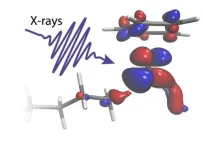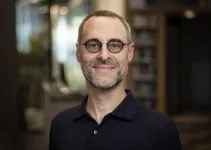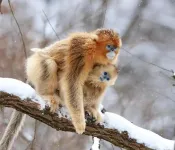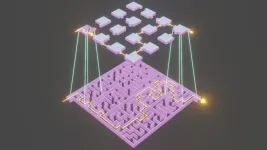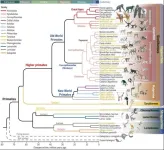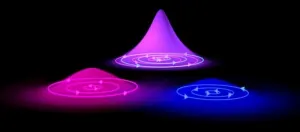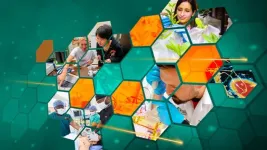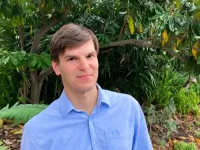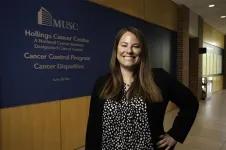(Press-News.org) Embargoed until 1-Jun-2023 14:00 ET (1-Jun-2023 18:00 GMT/UTC)
The use of short flashes of X-ray light brings scientists one big step closer toward developing better catalysts to transform the greenhouse gas methane into a less harmful chemical. The result, published in the journal Science, reveals for the first time how carbon-hydrogen bonds of alkanes break and how the catalyst works in this reaction.
Methane, one of the most potent greenhouse gases, is being released into the atmosphere at an increasing rate by livestock farming as well as the continuing unfreezing of permafrost. Transforming methane and longer-chain alkanes into less harmful and in fact useful chemicals would remove the associated threats, and in turn make a huge feedstock for the chemical industry available. However, transforming methane necessitates as a first step the breaking of a C-H bond, one of the strongest chemical linkages in nature.
Forty years ago, molecular metal catalysts were discovered that can easily split C-H bonds. The only thing found to be necessary was a short flash of visible light to “switch on” the catalyst and, as by magic, the strong C-H bonds of alkanes passing nearby are easily broken almost without using any energy. Despite the importance of this so-called C-H activation reaction, it remained unknown over the decades how that catalyst performs this function.
The research was led by scientists from Uppsala University in collaboration with the Paul Scherrer Institute in Switzerland, Stockholm University, Hamburg University and the European XFEL in Germany. For the first time, the scientists were able to directly watch the catalyst at work and reveal how it breaks those C-H bonds.
In two experiments conducted at the Paul Scherrer Institute in Switzerland, the researchers were able to follow the delicate exchange of electrons between a rhodium catalyst and an octane C-H group as it gets broken. Using two of the most powerful sources of X-ray flashes in the world, the X-ray laser SwissFEL and the X-ray synchrotron Swiss Light Source, the reaction could be followed all the way from the beginning to the end. The measurements revealed the initial light-induced activation of the catalyst within 400 femtoseconds (0.0000000000004 seconds) to the final C-H bond breaking after 14 nanoseconds (0.000000014 seconds).
“The time-resolved X-ray absorption experiments we performed are only possible at large-scale facilities like SwissFEL and the Swiss Light Source, which provide extremely bright and short X-ray pulses. The catalyst is immersed in a dense octane solution, but by taking the perspective of the metal, we could specifically pick the one C-H bond out of hundreds of thousands which is made to break,” explains Raphael Jay, Researcher at Uppsala University and lead experimentalist of the study.
To interpret the complex experimental data, theoreticians from Uppsala University and Stockholm University teamed up and performed advanced quantum-chemical calculations.
“Our calculations allow us to clearly identify how electronic charge flows between the metal catalyst and the C-H group in just the right proportion. We can see how charge flowing from the metal onto the C-H bond glues the two chemical groups together. Charge flowing in the opposite direction instead acts as a scissor that eventually breaks the C and the H atom apart,” explains Ambar Banerjee, Postdoctoral researcher at Uppsala University and lead theoretician of the study.
The study solves a forty-year-old mystery about how an activated catalyst can actually break strong C-H bonds by carefully exchanging fractions of electrons and without the need for huge temperatures or pressures. With their new tool to hand, the researchers next want to learn how to direct the flow of electrons to help develop better catalysts for the chemical industry in order to make something useful out of methane and other alkanes.
Facts
The study builds on the pioneering work of grandfather, father and son Manne, Kai, and Per Siegbahn.
Manne Siegbahn (Uppsala University), who received the Nobel Prize in Physics in 1924, pioneered how different elements can be distinguished by X-rays.
Kai Siegbahn (Uppsala University), who received the Nobel Prize in Physics in 1981, pioneered how different chemical environments of the same element can be distinguished by X-rays.
Per Siegbahn (Stockholm University) theoretically predicted the concerted exchange of electronic charge required for breaking a C-H bond.
END
X-rays visualize how one of nature’s strongest bonds breaks
2023-06-01
ELSE PRESS RELEASES FROM THIS DATE:
New study shows how adaptations to living in a cold climate promoted social evolution
2023-06-01
For the first time ever, scientists have uncovered evidence that a species’ long-term adaptation to living in an extremely cold climate has led to the evolution of social behaviours including extended care by mothers, increased infant survival and the ability to live in large complex multilevel societies.
The new study, published today in the journal Science, was led by researchers from Northwest University in China and a team including the University of Bristol (UK) and the University of Western Australia, ...
People divide complex tasks into simpler subtasks in a way that balances ease of planning with efficient behavior, consistent with a new computational theory
2023-06-01
Article URL: https://journals.plos.org/ploscompbiol/article?id=10.1371/journal.pcbi.1011087
Article Title: Humans decompose tasks by trading off utility and computational cost
Author Countries: USA
Funding: This research was supported by John Templeton Foundation grant 61454 awarded to TLG and NDD (https://www.templeton.org/), U.S. Air Force Office of Scientific Research grant FA 9550-18-1-0077 awarded to TLG (https://www.afrl.af.mil/AFOSR/), and U.S. Army Research Office grant ARO W911NF-16-1-0474 awarded to NDD (https://www.arl.army.mil/who-we-are/directorates/aro/). ...
LSU researchers show mobile elements monkeying around the genome
2023-06-01
Baboons (Papio) are found across the continent of Africa, from the west to the east and all the way south. They have doglike noses, impressive teeth and thick fur that ranges widely in color between the six species, which are olive, yellow, chacma, Kinda, Guinea and hamadryas. Their habitats vary from savannas and bushlands to tropical forests and mountains. Chacma baboons, the largest at up to 100 pounds, are even found in the Kalahari Desert, while the neighboring Kinda baboons, the smallest at around 30 pounds, stay near water. Most live in large troops with dozens or hundreds of members. While most baboons ...
The Primate Genome Project unlocks hidden secrets of primate evolution
2023-06-01
Co-led by Guojie Zhang from Centre for Evolutionary & Organismal Biology at Zhejiang University, Dong-Dong Wu at Kunming Institute of Zoology, Xiao-Guang Qi at Northwest University, Li Yu at Yunnan University, Mikkel Heide Schierup at Aarhus University, and Yang Zhou at BGI-Research, the Primate Genome Consortium reported a series of publications from its first phase program which includes high quality reference genomes from 50 primate species of which 27 were sequenced for the first time. These studies provide new insights on the speciation process, genomic diversity, social evolution, ...
Major primate genome sequencing studies reveal new insight into evolution, biodiversity and key applications for human health
2023-06-01
HOUSTON – (June 1, 2023) – A new investigation led by researchers at Baylor College of Medicine’s Human Genome Sequencing Center, the Institute of Evolutionary Biology and Pompeu Fabra University in Barcelona, Spain, and Illumina, Inc. analyzed the genomes of 233 nonhuman primate species and revealed key features of primate evolution, human disease and biodiversity conservation. The findings are published in a series of studies in a special issue of the journal Science.
The Primate Genome Project generated the most complete ...
Tiny quantum electronic vortexes can circulate in superconductors in ways not seen before
2023-06-01
Within superconductors little tornadoes of electrons, known as quantum vortices, can occur which have important implications in superconducting applications such as quantum sensors. Now a new kind of superconducting vortex has been found, an international team of researchers reports.
Egor Babaev, professor at KTH Royal Institute of Technology in Stockholm, says the study revises the prevailing understanding of how electronic flow can occur in superconductors, based on work about quantum vortices that was recognized in the 2003 Nobel Prize award. The ...
University of Miami selected to prestigious Association of American Universities
2023-06-01
The University of Miami has been chosen as one of the newest members of the esteemed Association of American Universities (AAU), a distinguished national organization of leading research universities founded in 1900.
The invitation to join the prestigious organization—considered the gold standard in American higher education—comes as the University’s research and sponsored program expenditures totaled more than $413 million in fiscal year 2022, demonstrating a critical focus to address the world’s most complex issues.
“There are special moments in the life of a university that not only reward our hard work but, more importantly, ...
Dr. Robert Harrington named dean of Weill Cornell Medicine
2023-06-01
Dr. Robert A. Harrington, a cardiologist and the Arthur L. Bloomfield Professor of Medicine and chair of the Department of Medicine at Stanford University, has been named the Stephen and Suzanne Weiss Dean of Weill Cornell Medicine and provost for medical affairs of Cornell University.
The appointment was approved by the Cornell Board of Trustees and the Weill Cornell Medicine Board of Fellows. Harrington - also a member of the National Academy of Medicine - will begin his new position on Sept. 12.
A past president of the American Heart Association (AHA), ...
Early career scientist wins prestigious Hungarian physics award
2023-06-01
Laszlo Horvath, an early career physicist at the U.S. Department of Energy’s (DOE) Princeton Plasma Physics Laboratory (PPPL) stationed at General Atomics in San Diego, is the winner of the 2022 Károly Simonyi Memorial Plaque from the Hungarian Nuclear Society. Established in 2007, the plaque “recognizes Hungarian researchers and engineers with outstanding achievements in the field of fusion plasma physics and technology.”
Horvath learned he had won the Simonyi Memorial Plaque not long ...
More evidence needed to confirm promise of remote or decentralized trials
2023-06-01
There’s one question that Hollings Cancer Center researcher Jennifer Dahne, Ph.D., co-director of the remote and virtual trials program at the South Carolina Clinical & Translational Research Institute, hears more than any other as she consults with clinical researchers about how to set up remote trials, also known as decentralized trials. Will these trials overcome the barriers that make it difficult for minority and underserved populations to participate in clinical trials? It’s also a question she often discusses ...
